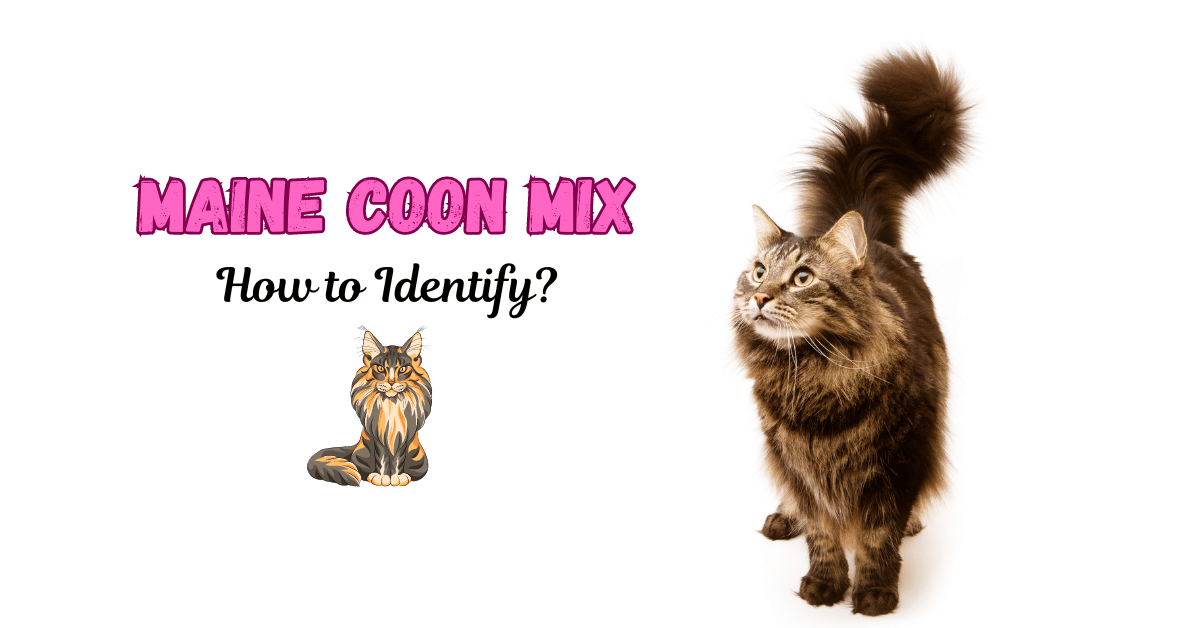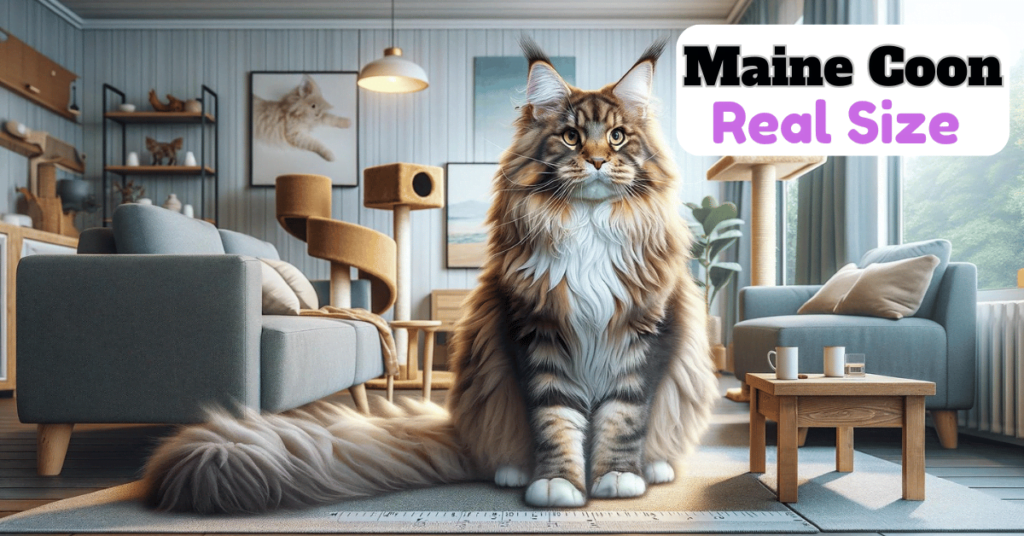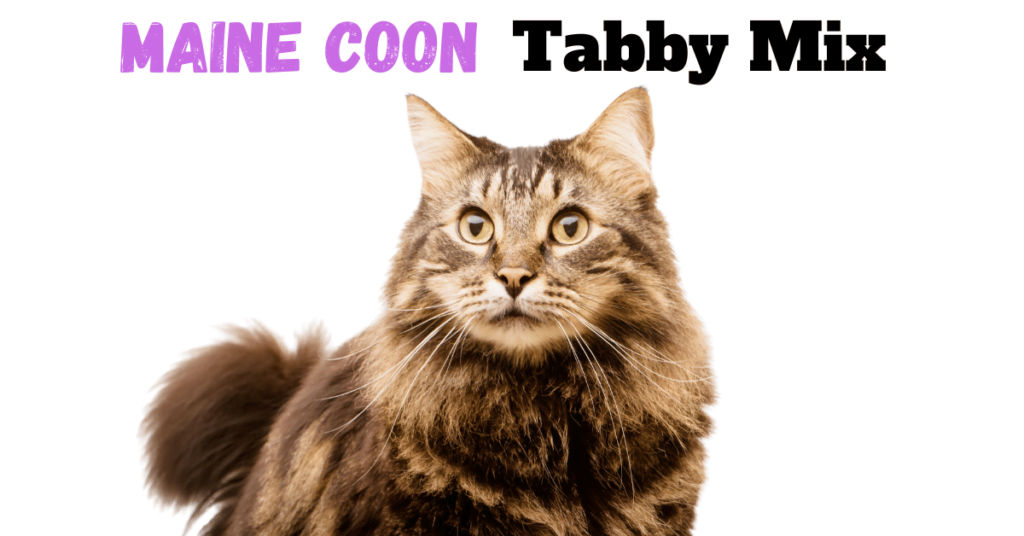This post contains affiliate links and I will be compensated if you make a purchase after clicking on my links.
Understanding the Maine Coon’s Appeal
The Maine Coon is not just another pretty face in the feline world; it’s a breed renowned for its striking size, majestic fur, and a demeanor that can only be described as regally approachable. Known as the “gentle giants” of the cat kingdom, Maine Coons have captivated hearts with their impressive physique and friendly nature.
However, many enthusiasts and potential cat owners often wonder: Is their beloved cat a full-blooded Maine Coon or a Maine Coon mix?Understanding the differences can be both a matter of curiosity and of care, especially when considering the health and behavior traits specific to the breed.
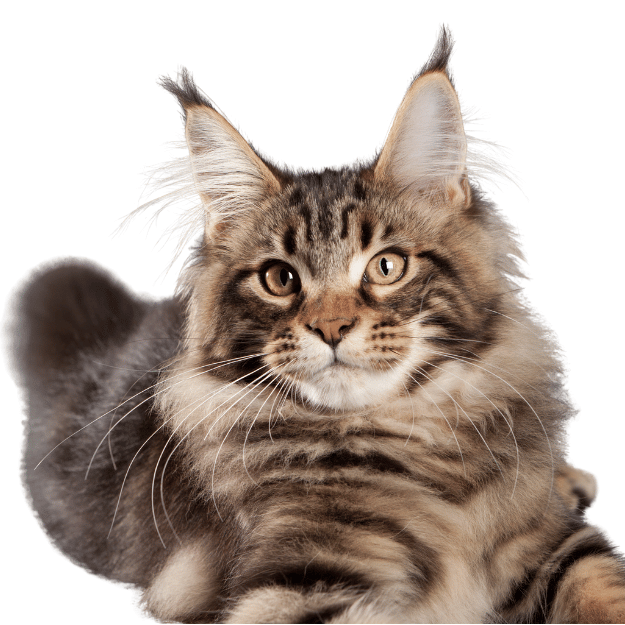
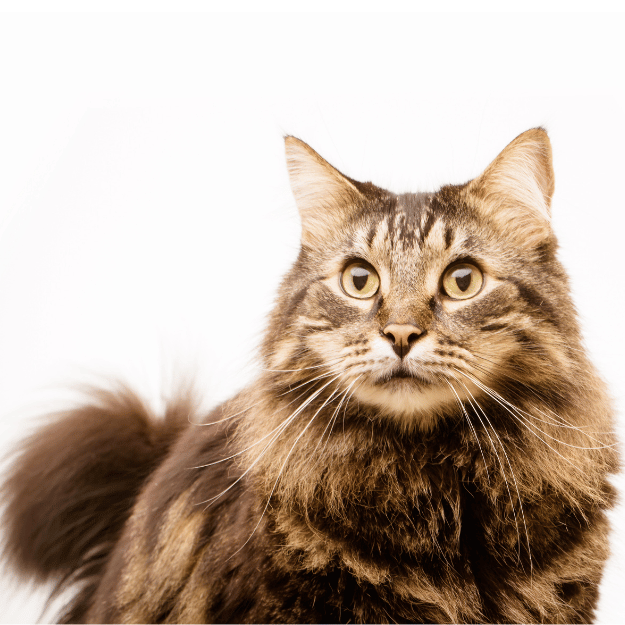
Tip: If your cat has a pedigree from a reputable breeder, it’s a purebred Maine Coon. Cats from shelters or found as strays are likely delightful Maine Coon mixes.
Coat Comparison: Purebred vs. Maine Coon Mix
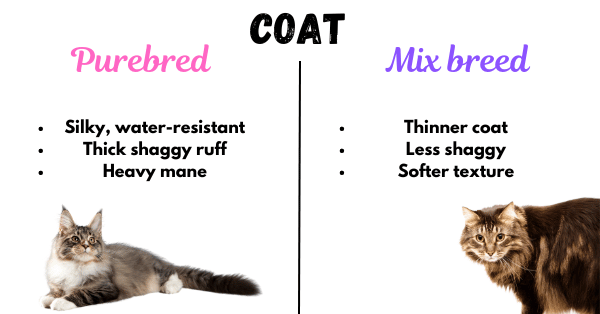
Thick Shaggy Fur of Purebreds
A purebred Maine Coon sports a silky coat that acts like armor against the cold climates of its namesake state, Maine. This coat features a dense, water-resistant undercoat and a longer, shaggy overcoat that provides substantial protection against moisture and cold weather.
The fur is particularly heavy around the neck (creating a lion-like ruff) and the tail, which is bushy and resembles that of a raccoon—hence the name.
Fact: Maine Coons appear in shades like brown, red, and silver tabby, often with white, and also in solid, calico, or black and white. However, pointed (like Siamese), lavender, and chocolate colors are disallowed. White or partly white Maine Coons may exhibit blue or other unusual eye colors.
Coat Variations in Maine Coon Mixes
In contrast, a Maine Coon mix may exhibit variations in the coat that hint at a genetic blend. The fur of a Maine Coon mix might not have the same thickness or water-resistance as a purebred’s. While they may still feature a bushy tail and some ruff around the neck, these areas are often less pronounced and the fur might be silkier or less dense.
Tip: If your cat has long hair but lacks the distinctive, heavy frontal ruff typical of Maine Coons, they may be a Maine Coon mix, not a purebred.
Distinguishing Maine Coon Mixes by Body Shape and Size
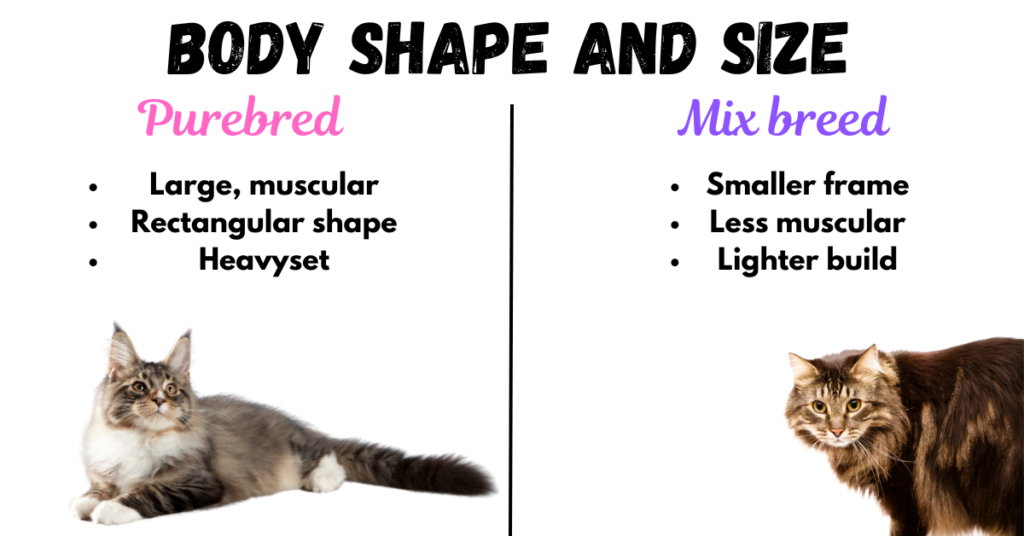
Stature and Frame of a Purebred Maine Coon
A purebred Maine Coon boasts a robust and rectangular body shape, emphasizing its muscular and powerful build. These cats are large, often weighing between 10 to 25 pounds and standing 10 to 16 inches at the shoulder.
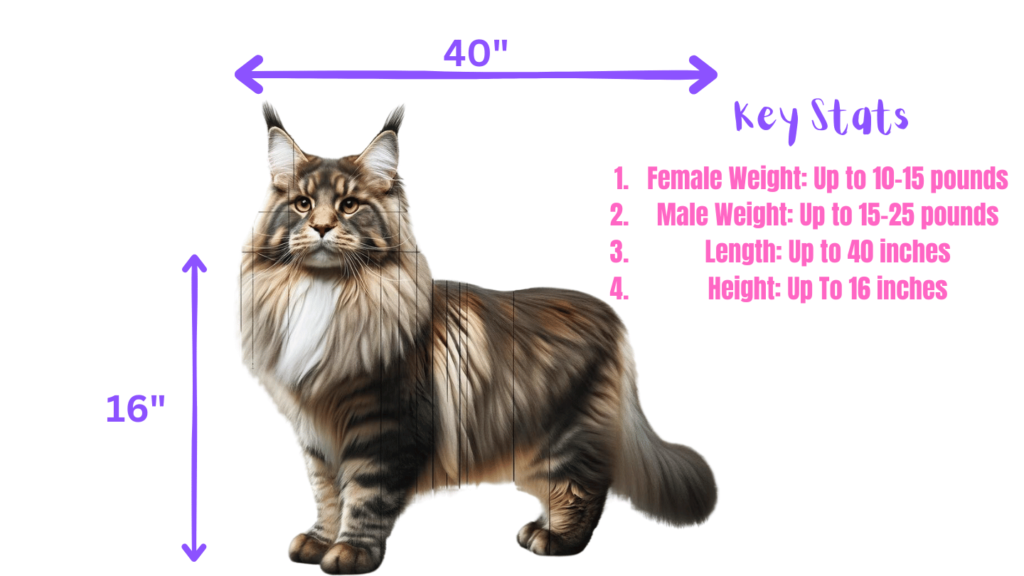
Their bodies are long and substantial, with total lengths, including the tail, reaching up to 40 inches. Equipped with large, strong bones, they have a notable heft and presence.
Physical Variations Found in Maine Coon Mixes
Maine Coon mixes often display more varied body shapes and sizes, deviating from the substantial dimensions typical of purebreds. They may also have a less pronounced bone structure, lacking the broad and lengthy frame characteristic of pure Maine Coons.
Maine Coon mixes often appear smaller and less muscular, typically ranging from petite to medium size, common among domestic cats. If a mature male Maine Coon weighs less than 15 pounds, it may indicate a mixed heritage, although several factors can influence this.
Ears and Face: Distinguishing Mix from Purebred
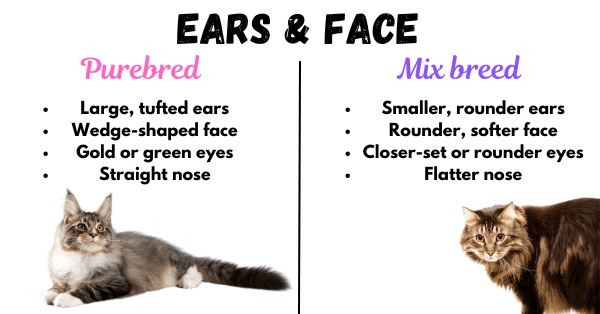
Purebred Maine Coon Ear & Face
Maine Coon ears are nothing short of a statement feature—distinctively large and adorned with lynx-like tufts that not only sharpen their hearing but also buffer against the chilly breezes, enhancing their wild and regal look. The fur within these ears is luxuriously long and prominent, adding an extra touch of nobility.
Moving to the face, the Maine Coon impresses with a robust wedge shape, anchored by a square muzzle and a strong, masculine jaw. Their eyes are captivating, typically gold or green, set beneath lofty cheekbones that scream intelligence and command respect. This noble visage is topped off with a straight nose, setting the pure Maine Coon apart in the feline world.
Maine Coon Mixes Ear and Face
Maine Coon mixes might sport ears that are a touch smaller and rounder, or perhaps even set a bit lower on the head, straying from the classic sharp, pointed silhouette seen in purebreds. The characteristic tufts may be less pronounced or missing altogether, toning down the breed’s signature wild flair.
Facial features in Maine Coon mixes often present a rounder, gentler contour with a softer jawline. The eyes may be closer set or rounder, deviating from the typical almond shape and straying from the usual gold and green colors.
Variations in eye placement or size, along with a flatter nose, can hint at a diverse genetic heritage and help distinguish mixes from straight-nosed purebreds
Tail Characteristics: Coon Purebred vs. Mix
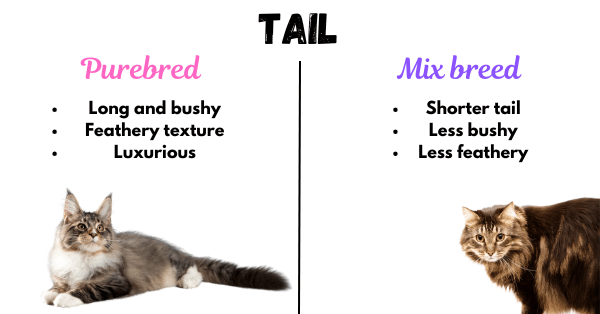
Purebred Maine Coon Tail Features
The tail of a Maine Coon is a signature feature, often as long as three-quarters of their body length and reminiscent of a raccoon’s bushy tail—hence part of the breed’s name. Characterized by its luxurious, feathery texture, the tail can extend up to 16 inches, broad at the base and tapering to a narrow point.
It’s not just for show; the thick, flowing fur serves as insulation against cold weather. If your cat’s tail can nearly reach their shoulder, you might indeed have a Maine Coon. This glorious plume is a proud display, often held high and always a sight to behold.
Tail Characteristics of Maine Coon Mixes
Maine Coon mixes often have tails that lack the grandeur of purebreds. Typically shorter and less bushy, their tails might not exhibit the lush, feathery quality seen in purebreds. If the tail is notably short, not reaching at least 10 inches or failing to touch the shoulder when curved around the side, it likely indicates a mix, reflecting the genetic diversity of Maine Coon mixes.
Additional Traits to Consider in Maine Coons
This section explores further distinctive traits that can help you identify whether your cat is a purebred Maine Coon or a Maine Coon mix.
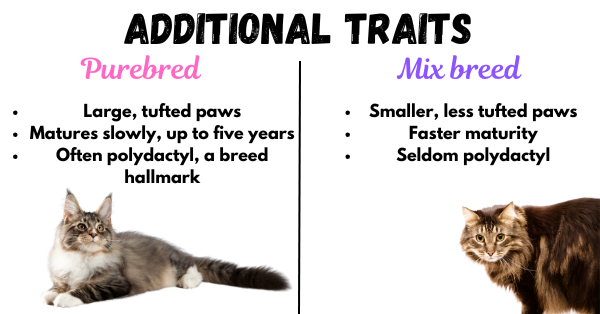
Powerful Paws
A purebred Maine Coon boasts large, well-tufted paws designed to navigate the snowy terrains of Maine with grace. These paws are not only sizable but also robust, supporting their adventurous lifestyle. If your cat exhibits Maine Coon-like features but has smaller, less tufted paws, it could be a sign they’re a mix, blending Maine Coon robustness with other feline traits.
Age of Maturity
Maine Coons are known for their delayed maturity. While most cat breeds reach full development within the first one to two years, Maine Coons can take up to five years to fully mature, both physically and mentally. This slow growth process, a characteristic of their large bodies and complex brains, sets them apart.
If your cat matures by two years or earlier, this quicker development could indicate that your Maine Coon is actually a mixed breed.
Polydactyl Traits
Not all Maine Coons carry the polydactyl gene, but those that do are often seen as a hallmark of the breed’s purebred status. This genetic trait results in extra toes, typically giving them six-toed paws. The presence of polydactyly in a Maine Coon is a notable characteristic that adds to their uniqueness.
This trait is celebrated in literary history as well, most famously by Ernest Hemingway, who adored polydactyl cats. His first such cat, a Maine Coon named Snow White, exemplifies the close association of this feature with the breed. If your Maine Coon has extra toes, it’s a strong indicator that you have a purebred.
Using Genetic Testing to Identify Maine Coon Mixes
Genetic testing offers valuable insights into your Maine Coon’s lineage, especially when its ancestry is unclear. By analyzing DNA samples, these tests can identify breed-specific markers and signs of genetic diversity, indicating whether your cat is a purebred or a mix.
Beyond breed identification, genetic testing also provides health information that can inform your cat’s future care and wellness.
Tip: You can easily buy a genetic testing kit, collect a sample from your cat, and send it to a lab for detailed insights.
Celebrating Maine Coon Mixes
Maine Coons and their mixes might look similar, but subtle differences can reveal their true lineage. Whether purebred or mix, their distinctive features—from luxurious tails to lynx-like ears—enhance your life with joy. Maine Coon mixes, with their majestic presence and unique heritage, deserve love and care just like any purebred.
Meet Sean, a fintech whiz with a penchant for pet purrs and blockchain buzz. After a decade of fintech feats, Sean’s tech talents leaped from ledger lines to litter lines, driven by a passion for pets and a vision for a more connected pet care community. With three critter companions as co-pilots, Sean launched this blog to share a treasury of pet-friendly tech tips and tales.

